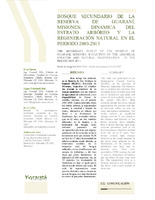Bosque secundario de la reserva de guaraní, misiones : dinámica del estrato arbóreo y la regeneración natural en el período 2003-2015
The secondary forest of the reserve of guarani, misiones : evolution of the arboreal stratum and natural regeneration in the period 2003-2015
Date
2017-11-01Author
Vera, Norma Esther
López Cristóbal, Lidia Mirta
Reyes, Lidia Mabel
Mallorquín, Alan Emanuel
Metadata
Show full item recordAbstract
Este trabajo fue realizado en la Reserva de Uso Múltiple de Guaraní (RUMG), Provincia de Misiones, Argentina. El objetivo fue evaluar la dinámica de un bosque secundario con uso anterior de agricultura de subsistencia y con disponibilidad de fuente de semillas cercana, en el periodo 2003-2015. Fueron relevados datos del estrato arbóreo, la regeneración natural, la cantidad y tamaño de claros, afectación de árboles por lianas y la dominancia de bambúceas. Los resultados indican que en 12 años, no hay cambios relevantes en la riqueza y la diversidad del bosque; estos atributos presentan una recuperación más lenta que algunos parámetros de la estructura como la dominancia total que alcanzó 36,54 m2/ha a los 47 años. La densidad de árboles continúa siendo elevada; se observaron cambios en la estructura total del bosque reflejados en las distribuciones del número de individuos y del área basal por clases diamétricas. Se relevaron 25.208 renovales /ha, de 35 especies. La dominancia de bambúceas es baja, al igual que la afectación de árboles por lianas. El ciclo de regeneración como proceso dinámico aún es incipiente en este bosque, con baja frecuencia de claros de pequeñas dimensiones. This study was performed on the Multipurpose Guarani Reserve (RUMG), in the province of Misiones, Argentina. The objective was to evaluate the evolution of a secondary forest with previous land use of subsistence agriculture and source of seed available nearby, in the period 2003-2015. Data collected include tree layer, natural regeneration, the amount and size of clear-cuts, effect on trees by vines and bamboo dominance. The results indicate no significant changes over the 12 year period in the richness and diversity of the forest, however, these variables have a slower recovery than some structure parameters such as the total dominance, which has reached 36,54 m2/ ha in 47 years. Tree density remains high; changes observed in the overall structure of the forest were reflected in the distributions of the number of individuals and basal area by diameter class. These were recorded as 25208 saplings/ ha and 35 species. Dominance of bamboo and the effect of vines were both low. The regeneration cycle as a dynamic process is still incipient in this forest, with a small number of clear-cuts.
URI
https://hdl.handle.net/20.500.12219/2670http://www.yvyrareta.com.ar/index.php/component/k2/item/59-bosque-2rio-reser-guara
Collections
- Revista Yvyraretá [360]
The following license files are associated with this item:




